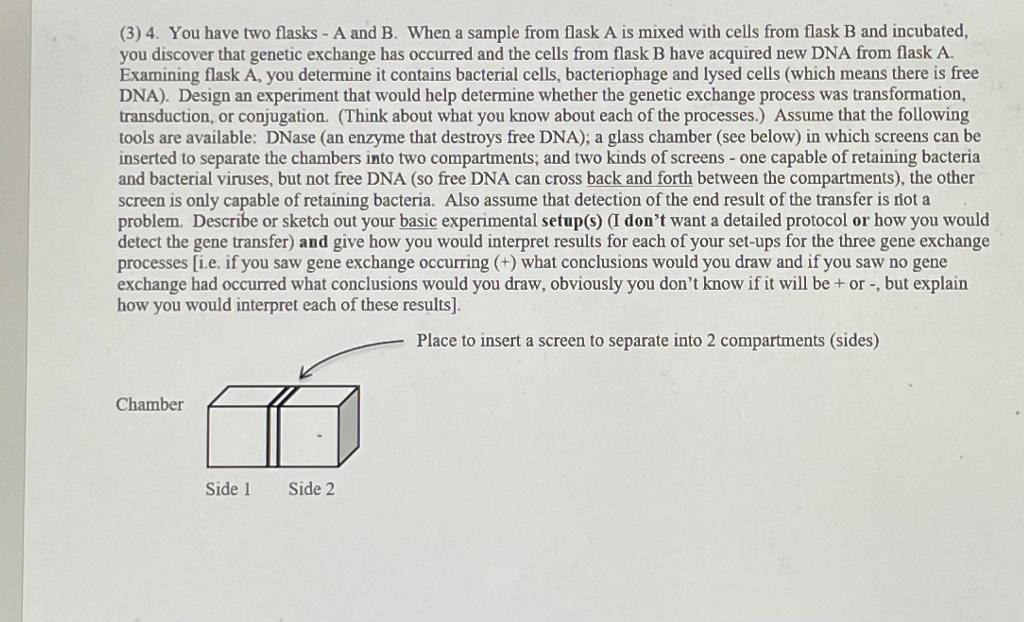 thank you
thank you
(3) 4. You have two flasks - A and B. When a sample from flask A is mixed with cells from flask B and incubated, you discover that genetic exchange has occurred and the cells from flask B have acquired new DNA from flask A. Examining flask A, you determine it contains bacterial cells, bacteriophage and lysed cells (which means there is free DNA). Design an experiment that would help determine whether the genetic exchange process was transformation, transduction, or conjugation. (Think about what you know about each of the processes.) Assume that the following tools are available: DNase (an enzyme that destroys free DNA); a glass chamber (see below) in which screens can be inserted to separate the chambers into two compartments; and two kinds of screens - one capable of retaining bacteria and bacterial viruses, but not free DNA (so free DNA can cross back and forth between the compartments), the other screen is only capable of retaining bacteria. Also assume that detection of the end result of the transfer is not a problem. Describe or sketch out your basic experimental setup() (I don't want a detailed protocol or how you would detect the gene transfer) and give how you would interpret results for each of your set-ups for the three gene exchange processes [i.e. if you saw gene exchange occurring (+) what conclusions would you draw and if you saw no gene exchange had occurred what conclusions would you draw, obviously you don't know if it will be + or -, but explain how you would interpret each of these results). Place to insert a screen to separate into 2 compartments (sides) Chamber Side 1 Side 2 (3) 4. You have two flasks - A and B. When a sample from flask A is mixed with cells from flask B and incubated, you discover that genetic exchange has occurred and the cells from flask B have acquired new DNA from flask A. Examining flask A, you determine it contains bacterial cells, bacteriophage and lysed cells (which means there is free DNA). Design an experiment that would help determine whether the genetic exchange process was transformation, transduction, or conjugation. (Think about what you know about each of the processes.) Assume that the following tools are available: DNase (an enzyme that destroys free DNA); a glass chamber (see below) in which screens can be inserted to separate the chambers into two compartments; and two kinds of screens - one capable of retaining bacteria and bacterial viruses, but not free DNA (so free DNA can cross back and forth between the compartments), the other screen is only capable of retaining bacteria. Also assume that detection of the end result of the transfer is not a problem. Describe or sketch out your basic experimental setup() (I don't want a detailed protocol or how you would detect the gene transfer) and give how you would interpret results for each of your set-ups for the three gene exchange processes [i.e. if you saw gene exchange occurring (+) what conclusions would you draw and if you saw no gene exchange had occurred what conclusions would you draw, obviously you don't know if it will be + or -, but explain how you would interpret each of these results). Place to insert a screen to separate into 2 compartments (sides) Chamber Side 1 Side 2
 thank you
thank you





